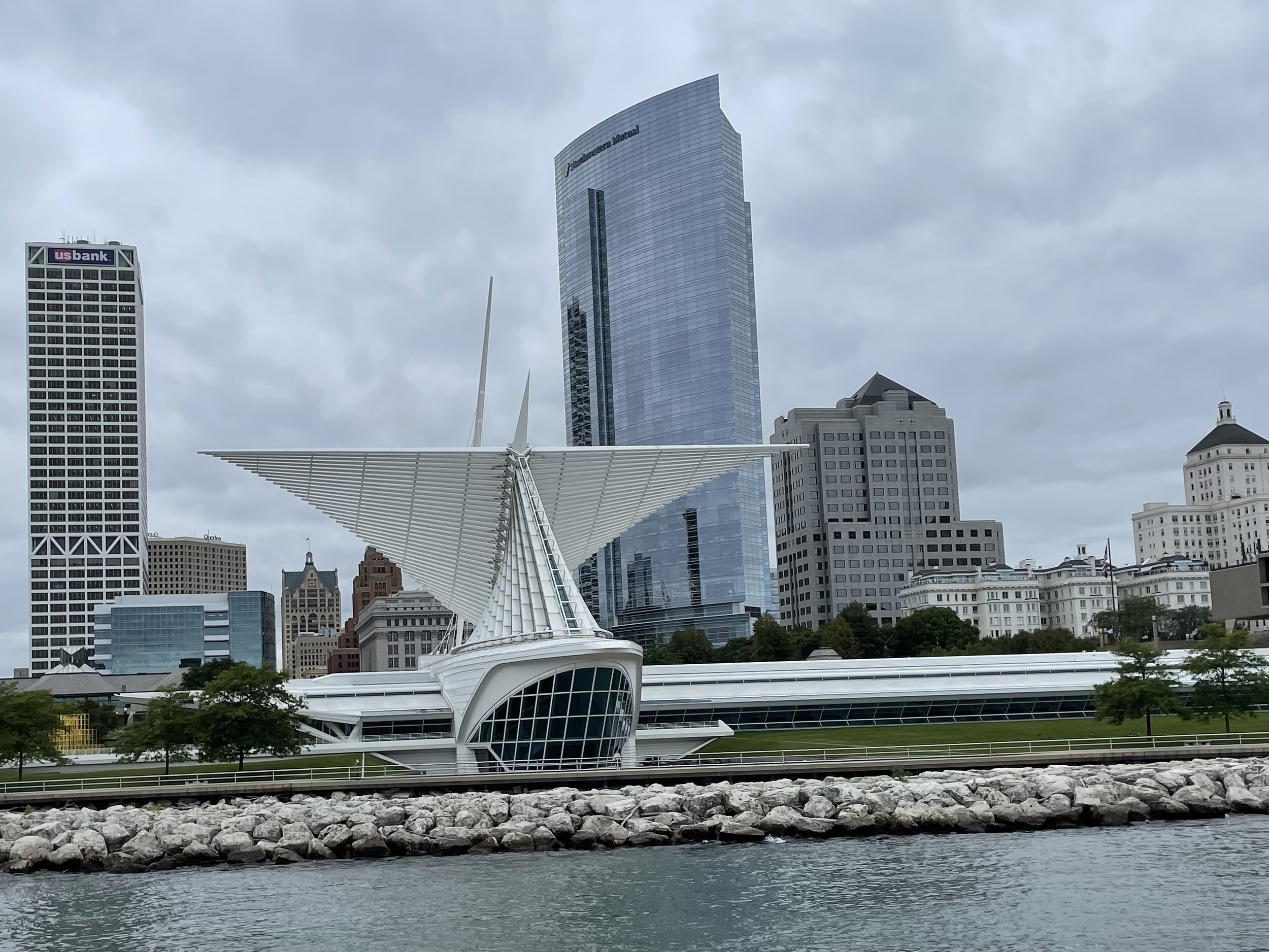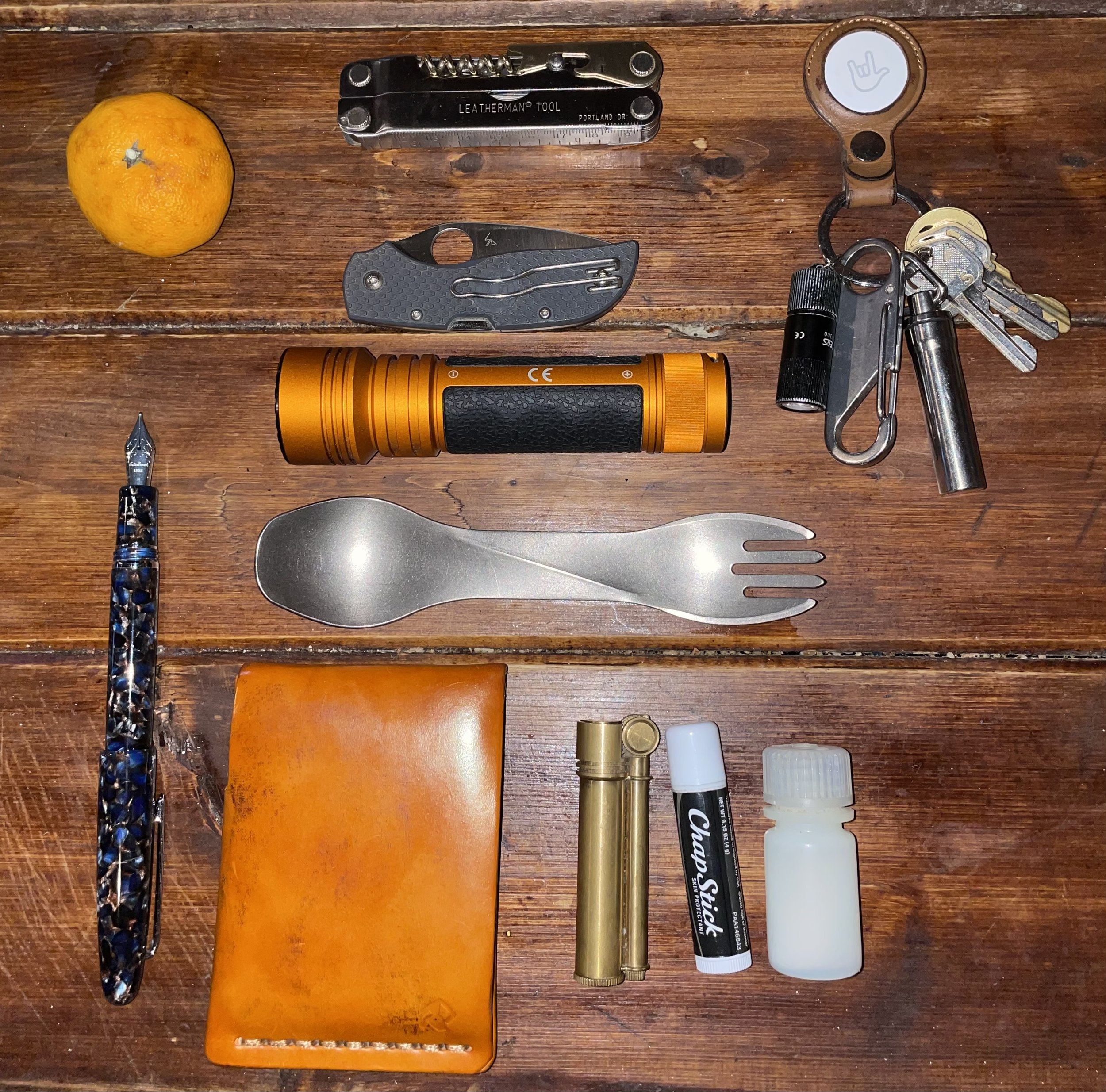Perhaps the best part of travelling without a strict timetable is being able to stop wherever, whenever. This explains how we found ourselves in Milwaukee, a city that - to be honest - was not on my rather prodigious bucket list.
Located a few hours north of Chicago on the western shore of Lake Michigan, Milwaukee, it turns out, is a little nugget of malted barley filled with beautiful architecture, a vibrant riverfront, incredible art, and, oh yes, beer. Lots and lots of beer.
We are on our way to Door County, Wisconsin, which is a peninsula that juts out into Lake Michigan and is said to be the “Cape Cod of the mid-west.” We will be partaking in a five day organized biking trip. As we swung north from Chicago the city of Milwaukee presented itself for consideration. With several days still before we needed to be in Door County we were totally like, why not?
The night before we had been camping in Indiana Dunes National Park, a lovely spot except for two things: it was hotter than hell, and the mosquitos were abundant and thirsty. We had set up the tent which is both cooler and better protection from the mozzies than the van, but it was a sticky, itchy night notwithstanding. The fact that there are no campgrounds in downtown Milwaukee meant that we would need to stay in a hotel, one with air conditioning and comfy beds. Such a shame, but there you are.
Inside the future at the Milwaukee Museum of Art
Our hotel was about 20 minutes from downtown, and we headed first to the Milwaukee Museum of Art, which boasts a stunning building designed by Spanish architect Santiago Calatrava, who was inspired by Frank Lloyd Wright. The place reminded me of the space station from the 1968 film “2001: A Space Odyssey.” Its spacious underground parking garage also served as a convenient place to stash the van for the day as we walked around the city.
We spent several hours in the museum, which features a design exhibit (I love those) as well as an impressive collection of American and European art including, rather surprisingly, one of the largest collections of Georgia O’Keefe paintings anywhere. The museum deserved more time but after a few hours, we were hungry both for food and to see more of the city.
The weather was still hot and sticky, but we ventured out into the streets of downtown, heading first for the public market, which is evocative of the Pike Place Market in Seattle. Among the dazzling number of choices, we selected a place that made panini sandwiches. I chose a tuna melt while Barbara picked the Mediterranean, a combo of cheese, tomatoes, and peppers. The sandwiches were so generous that we each ate only half and saved the remainder for dinner.
From there we made a beeline to the “world famous” National Bobblehead Hall of Fame and Museum. Here you can see every sports star in history and many other famous political and entertainment personalities immortalized as a little plastic statue with an oversize head that is attached with a spring. Why? Again, I ask why? We paid $5 each for admission and then paid our respects. I was disappointed not to find any of the Marx Brothers there. Nor did I see Steve Jobs or Tim Cook. However, Judy Garland was there in her Dorothy persona, as all the U.S. Presidents and Mr. Spock from Star Trek, his hand in the traditional hand shape of the Kohanim. Live Long and Prosper, old friend.
…to boldly go where no head has bobbled before.
Next we walked around the downtown and along the river. The river has multiple bridge crossings, all of which open to allow boat traffic through. Some of the bridges open drawbridge style while others lift straight up into the air like an elevator. Regardless of how they open, when they do all foot and vehicle traffic on the bridges comes to a halt while the boats go by below. At one such crossing, I spotted the Vista Queen, which, the internet informed me, has a sightseeing tour every day at 2 pm. We had obviously missed that day’s tour, which clinched the argument already raging in my brain. We’d need a second day in Milwaukee.
But first there was a required visit to Downtown Books, a massive used bookstore on Wisconsin Ave. More overwhelming than the sheer number of books was the geography of the store, with books towering from floor to the tops of the 15-foot ceilings. You’d need binoculars to read the titles on the highest shelves. Just the cookbook section alone was dozens of shelves filed by title rather than by author or cuisine. In short, it was impossible to find anything that you might be looking for except by chance. I left without making a purchase.
Emerging from our hotel on day two, we were struck by a chilly and meaningful breeze. Sometime during the night, autumn had swept in and temperatures had plunged. The crisp air was a relief after the sweltering days of the past week.
Soon we were parked near the dock for the Vista Queen and walking through the urban campus of Marquette University, a private, Jesuit institution, toward the mansion built by Captain Fredrick Pabst, 19th century steamboat captain and beer magnate. The good cap’n built the mansion (now a museum) in the late 1800s to celebrate his wealth and good fortune and to house his family on what was then Milwaukee’s poshest boulevard, the appropriately named Grand Avenue.
Pabst Mansion: the house that hops built
A struggling immigrant from Saxony (now part of Germany), Pabst had begun life with very modest means, making a living bussing restaurant tables and eventually working his way to becoming the captain on a lake steamboat. He married into the beer business, and his father-in-law taught him all there was to know about brewing. The captain eventually took over the business. I am not sure if Pabst Blue Ribbon was as bad a beer then as it is today but people must have had a taste for the stuff. He made a fortune.
The mansion is breathtaking. Much of it has original furnishings, wall coverings and floors. Ahead of its time, the mansion had electricity, an elevator, even a telephone (albeit one attached to the wall) at the time of its construction. The hour-long tour was excellent. Unlike most of these kinds of tours, you can go anywhere in the house. There are no ropes and no restrictions except don’t touch anything and don’t sit on the furniture. Our guide was knowledgeable and amusing. Sadly, I am sorry to report we weren’t offered so much as an ounce of beer. The captain himself apparently preferred wine. The house has a wine cellar with a capacity of more than 3,000 bottles. All of which have long since been consumed.
With our cruise departing in less than 90 minutes, lunch was the next priority and, on our way, back to the dock we stumbled on Brick 3 Pizza, which claims to be “Bringing the Big Apple to Milwaukee.”
“I’ll be the judge of that,” I thought.
Four slices at Brick 3
With our optimistically large eyes, we ordered two slices each. I got a cheese slice (there is nothing more defining of the class than the cheese slice) and a Californian, which had fresh tomatoes and, as it turned out, enough garlic to discourage even the most amorous vampire. Barbara got a slice of Californian as well along with one that was spinach and feta. The four slices flew into to the traditional stainless steel pizza ovens (not sure where the “brick” comes in) and a minute or two later were delivered to our table on paper plates. They were hot enough to scald the skin off the roof of ones mouth, which I proceeded to do without further ado.
The pizza was a very respectable New York slice. The crust was perfectly thin, the cheese stretchy and a little sour, the sauce light and tart (not sweet). New York style pizza is always judged pass/fail. This passed easily.
We each ended up saving one of our slices to eat later. We complimented the man behind the counter (the owner, I am guessing) and found out that he hailed from Staten Island. I told him that I was born in Queens. It turned out both our earliest memories were of the 1964-65 World’s Fair.
I didn’t have the heart to tell him that Staten Island isn’t really New York City.
Upscale condos line the Milwaukee River
Pizza box in hand, we dashed off to our rendezvous with the Vista Queen.
We found seats in the bow of the boat and soon we were underway. We were soaring under the bridges that we had walked across the day before. Our young guide was mostly very knowledgeable, though she identified a 19th century red brick building that looked to me like New York’s Carnegie Hall as “Brutalist” architecture. Barbara and I looked at each other bewildered but the guide was quickly schooled by the boat captain. The next time she pointed out a Brutalist building, she got it right.
The art museum as seen from the lake
From the boat we got an up-close view of the city’s historic Third Ward before heading out into the waters of Lake Michigan for a gorgeous view of the city skyline and the aforementioned art museum. It was chilly and windy on the water especially in the bow of the boat and we were pretty happy to get back to the dock and head back to the hotel for a few IPAs (not PBRs) chilling in the fridge.
The list of the world’s great cities is long. London, New York, L.A., Paris, Tokyo, Trenton. These are the destinations we put on the list and check off when/if we finally get to visit. But often it is the places you end up by accident that have the greatest capacity to surprise and delight. Perhaps it is precisely because we come to such places without expectations, without demands, without anxiety that they will prove worth the trouble, worth the funds expended, that we approach them with an open heart.
Milwaukee is just such a city. It graciously forgives you - not for having written it off - but for never having thought of it at all. Then it courts you with humor, good food, incredible art, and beer. It’s a place that makes you think: In different life I could have been happy here.
The world’s a narrow bridge; fear nothing.










